
|
It brightened up to -3 mag due to the forward scattering on Oct. 9 in the SOHO coronagraph images (Q.-c. Zhang, Charles S. Morris). It became a great comet of 0 mag on the ground. Now it is 8.8 mag (Nov. 23, Virgilio Gonano). Fading rapidly. In the Northern Hemisphere, it will be getting lower gradually after this, and it will be unobservable in January. But it will be observable again in January. In the Southern Hemisphere, it is not observable now, but it will appear in March.
Date(TT) R.A. (2000) Decl. Delta r Elong. m1 Best Time(A, h)
Nov. 23 18 55.99 4 13.7 1.716 1.333 50 8.1 18:19 ( 71, 32)
Nov. 30 19 6.36 4 26.9 1.929 1.455 47 8.6 18:18 ( 74, 29)
|

|
Brightening rapidly. It is expected to brighten up to 10 mag until Decemebr. Now it is 11.9 mag (Nov. 23, Katsumi Yoshimoto). It brightens up to 9.5 mag, but it will turn to fade out rapidly after that. It will be fainter than 18 mag in March. In the Northern Hemisphere, it stays observable in good condition. In the Southern Hemisphere, it will be unobservable in December.
Date(TT) R.A. (2000) Decl. Delta r Elong. m1 Best Time(A, h)
Nov. 23 11 37.56 24 16.5 0.792 1.117 76 10.4 5:13 (282, 59)
Nov. 30 12 14.55 38 7.4 0.636 1.113 83 9.9 5:19 (254, 62)
|

|
It returned for the first time in 68 years. It brightened up to 6.2 mag in early summer (July 1, Virgilio Gonano). Now it is 10.1 mag (Nov. 10, Mike Olason). Fading gradually. Now it is not observable. It will appear in January.
Date(TT) R.A. (2000) Decl. Delta r Elong. m1 Best Time(A, h)
Nov. 23 16 25.75 -10 2.8 3.304 2.351 12 11.2 18:19 ( 82, -6)
Nov. 30 16 37.67 -11 17.8 3.387 2.425 10 11.5 18:18 ( 83,-10)
|
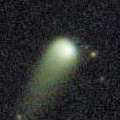
|
Now it is 12.9 mag (Nov. 11, Osamu Miyazaki). Fading slowly. In the Northern Hemisphere, it stays observable in good condition. In the Southern Hemisphere, it is not observable now.
Date(TT) R.A. (2000) Decl. Delta r Elong. m1 Best Time(A, h)
Nov. 23 5 34.34 67 19.9 3.003 3.720 130 11.7 1:30 (180, 58)
Nov. 30 4 54.19 68 17.1 2.986 3.731 133 11.7 0:22 (180, 57)
|

|
Bright new Kreutz sungrazer comet. Large outburst occured on Oct. 18 and it brightened up to 8.2 mag (Oct. 20, Martin Masek). It approached to Sun down to 0.008 a.u. on Oct. 28. It was expected to brighten up to 2 mag, or -4.5 mag at best. However, it completely disappered at the perihelion. It is appearing in the morning sky, but probably nothing remains.
Date(TT) R.A. (2000) Decl. Delta r Elong. m1 Best Time(A, h)
Nov. 23 11 39.14 -31 48.9 0.968 0.944 57 11.7 5:13 (330, 16)
Nov. 30 11 4.68 -35 59.9 0.959 1.111 69 12.3 5:19 (345, 17)
|

|
It approaches to Sun down to 0.09 a.u. on Jan. 13. According to the calculation, it will brighten up to -1 mag. But probably, it will be disintegrated. At the high light, it may be observable after the perihelion passage only in the Southern Hemisphere. Now it is 11.9 mag (Oct. 30, Chris Wyatt). Brightening rapidly. In the Northern Hemisphere, it will never be observable after this. In the Southern Hemisphere, it will be unobservable in December.
Date(TT) R.A. (2000) Decl. Delta r Elong. m1 Best Time(A, h)
Nov. 23 15 35.73 -41 56.6 2.301 1.434 21 12.4 5:13 (305,-25)
Nov. 30 15 51.48 -40 56.0 2.170 1.293 20 11.8 5:19 (306,-22)
|

|
Now it is 13.4 mag (Oct. 31, Thomas Lehmann). It stays 14 mag for a while. It will be unobservable in January in the Northern Hemisphere, or in December in the Southern Hemisphere. But it will be observable again in February in the Northern Hemisphere.
Date(TT) R.A. (2000) Decl. Delta r Elong. m1 Best Time(A, h)
Nov. 23 19 1.91 -22 47.1 2.988 2.369 43 13.1 18:19 ( 48, 14)
Nov. 30 19 14.42 -20 52.8 3.051 2.373 39 13.2 18:18 ( 52, 14)
|

|
It returns for the first time in 70 years. It brightened up to 3.7 mag in early April (Apr. 6, Jose Guilherme Aguiar). Now it is 14.6 mag (Oct. 22, Hidetaka Sato). Fading slowly. In the Northern Hemisphere, it is not observable now, but it will appear in February. It locates somewhat low in the Southern Hemisphere. But it will become high in winter.
Date(TT) R.A. (2000) Decl. Delta r Elong. m1 Best Time(A, h)
Nov. 23 15 34.60 -47 40.8 4.091 3.249 27 13.1 5:13 (311,-27)
Nov. 30 15 46.18 -47 45.1 4.172 3.326 27 13.3 5:19 (313,-24)
|

|
It is expected to brighten up to 13.5 mag, and it will be observable in good condition in winter. Now it is 14.8 mag (Nov. 13, ATLAS Chile). It will turn to fade out rapidly after the peak. In the Northern Hemisphere, it stays observable in good condition. In the Southern Hemisphere, it will be getting lower gradually after this, and it will be unobservable in January.
Date(TT) R.A. (2000) Decl. Delta r Elong. m1 Best Time(A, h)
Nov. 23 5 55.41 -2 37.0 0.810 1.704 142 13.9 1:48 ( 0, 52)
Nov. 30 5 29.76 5 5.0 0.756 1.708 157 13.7 0:56 ( 0, 60)
|
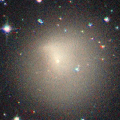
|
Major outburst occcured between Nov. 1 and 2. Now it is 11.9 mag (Nov. 11, ATLAS-HKO, Haleakala). In the Northern Hemisphere, it stays observable in good condition. In the Southern Hemisphere, it will be getting higher gradually.
Date(TT) R.A. (2000) Decl. Delta r Elong. m1 Best Time(A, h)
Nov. 23 10 10.76 9 31.5 6.174 6.246 89 13.9 5:13 (333, 62)
Nov. 30 10 11.98 9 18.1 6.061 6.247 96 13.9 5:19 (350, 64)
|

|
It became much brighter than expected. Now it is 13.1 mag (Nov. 1, Thomas Lehmann). It will fade out rapidly after this. In the Northern Hemisphere, it will be getting higher gradually. In the Southern Hemisphere, it is not observable now, but it will appear in February.
Date(TT) R.A. (2000) Decl. Delta r Elong. m1 Best Time(A, h)
Nov. 23 15 38.05 31 38.4 2.170 1.747 52 14.1 5:13 (241, 15)
Nov. 30 15 57.31 29 9.1 2.226 1.782 51 14.3 5:19 (245, 16)
|

|
Now it is 14.9 mag (Nov. 3, Hiroshi Abe). It stays 14 mag for a while. It stays observable in good condition.
Date(TT) R.A. (2000) Decl. Delta r Elong. m1 Best Time(A, h)
Nov. 23 6 44.57 3 10.2 5.137 5.879 135 14.3 2:37 ( 0, 58)
Nov. 30 6 42.80 3 21.5 5.054 5.861 141 14.3 2:07 ( 0, 58)
|

|
Now it is 14.1 mag (Aug. 29, Chris Wyatt). It stays 14 mag for a while. It locates somewhat low in the Northern Hemisphere. But it will become high in winter. In the Southern Hemisphere, it is not observable now, but it will appear in December.
Date(TT) R.A. (2000) Decl. Delta r Elong. m1 Best Time(A, h)
Nov. 23 14 24.85 -19 18.4 5.924 5.016 21 14.4 5:13 (294, 0)
Nov. 30 14 31.81 -19 19.0 5.885 5.022 26 14.4 5:19 (298, 5)
|

|
Now it is 12.5 mag (Nov. 20, Mike Olason). It will fade out rapidly after this. It will be fainter than 18 mag in March. It will be unobservable in February in the Northern Hemisphere, or in December in the Southern Hemisphere.
Date(TT) R.A. (2000) Decl. Delta r Elong. m1 Best Time(A, h)
Nov. 23 19 5.90 -23 10.6 2.230 1.671 44 14.5 18:19 ( 47, 15)
Nov. 30 19 27.37 -22 4.2 2.284 1.690 42 14.7 18:18 ( 49, 15)
|

|
It is expected to brighten up to 13 mag in 2025 autumn, and it will be observable in good condition. Now it is 14.6 mag (Nov. 3, Hiroshi Abe). It stays 15 mag for a while. It will be getting lower gradually after this, and it will be unobservable in February in the Southern Hemisphere, or in March in the Northern Hemisphere.
Date(TT) R.A. (2000) Decl. Delta r Elong. m1 Best Time(A, h)
Nov. 23 22 40.34 -4 58.4 4.142 4.404 98 14.5 18:30 ( 0, 50)
Nov. 30 22 43.20 -4 40.8 4.218 4.375 92 14.5 18:18 ( 5, 50)
|

|
First return of a new periodic comet which brightened up to 16 mag in 2012. Now it is 14.7 mag (Nov. 13, ATLAS-HKO, Haleakala). It will fade out rapidly after this. It will be fainter than 18 mag in February. In the Northern Hemisphere, it stays observable in good condition. In the Southern Hemisphere, it will be unobservable in December.
Date(TT) R.A. (2000) Decl. Delta r Elong. m1 Best Time(A, h)
Nov. 23 3 54.73 44 27.8 0.901 1.847 155 14.6 23:42 (180, 80)
Nov. 30 3 37.58 47 48.1 0.931 1.861 152 14.8 22:58 (180, 77)
|
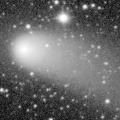
|
It brightened up to 9.6 mag from February to March (Feb. 25, Thomas Lehmann). Now it is 14.7 mag (Nov. 3, Thomas Lehmann). Fading slowly. In the Northern Hemisphere, it will be getting lower gradually. But it will be getting higher again after March. In the Southern Hemisphere, it is not observable now.
Date(TT) R.A. (2000) Decl. Delta r Elong. m1 Best Time(A, h)
Nov. 23 20 31.03 34 56.9 3.791 3.844 85 15.0 18:19 ( 99, 66)
Nov. 30 20 39.71 34 0.4 3.923 3.914 82 15.1 18:18 ( 98, 62)
|

|
Now it is 16.7 mag (Nov. 3, Hiroshi Abe). It stays 15 mag for a while. In the Northern Hemisphere, it stays observable in good condition. In the Southern Hemisphere, it is not observable now.
Date(TT) R.A. (2000) Decl. Delta r Elong. m1 Best Time(A, h)
Nov. 23 8 22.43 71 35.3 1.981 2.577 116 15.1 4:15 (180, 54)
Nov. 30 8 33.30 72 42.8 1.952 2.576 118 15.1 3:59 (180, 52)
|

|
Now it is 15.8 mag (Nov. 4, Thomas Lehmann). It stays 15 mag for a while. In the Northern Hemisphere, it stays observable in good condition.
Date(TT) R.A. (2000) Decl. Delta r Elong. m1 Best Time(A, h)
Nov. 23 9 11.76 20 55.1 2.221 2.678 106 15.3 5:03 ( 0, 76)
Nov. 30 9 15.64 20 28.9 2.128 2.670 112 15.2 4:40 ( 0, 75)
|

|
Brightening rapidly. Now it is 15.0 mag (Nov. 8, Ken-ichi Kadota). Brightening slowly. It locates somewhat low in the Northern Hemisphere. In the Southern Hemisphere, it is not observable now. It will brighten up to 14 mag from winter to spring. But it is not observable at the high light.
Date(TT) R.A. (2000) Decl. Delta r Elong. m1 Best Time(A, h)
Nov. 23 17 3.71 35 53.5 2.676 2.319 58 15.6 18:19 (117, 26)
Nov. 30 17 25.66 35 23.0 2.616 2.268 58 15.4 18:18 (117, 25)
|
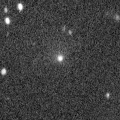
|
Very large comet. It is expected to brighten up to 13 mag in 2031. Now it is 15.3 mag (Nov. 10, Thomas Lehmann). It stays 15 mag for a while. In the Northern Hemisphere, it is not observable now. In the Southern Hemisphere, it stays observable in good condition. In the Northern Hemisphere, it is not observable until 2030.
Date(TT) R.A. (2000) Decl. Delta r Elong. m1 Best Time(A, h)
Nov. 23 3 58.14 -70 45.5 15.708 15.720 88 15.4 23:45 ( 0,-16)
Nov. 30 3 54.09 -70 48.9 15.711 15.697 87 15.4 23:13 ( 0,-16)
|

|
Now it is 15.3 mag (Nov. 6, Toshihiko Ikemura, Hirohisa Sato). Fading gradually. It will be fainter than 18 mag in February. In the Northern Hemisphere, it stays observable in good condition. In the Southern Hemisphere, it will be getting lower gradually.
Date(TT) R.A. (2000) Decl. Delta r Elong. m1 Best Time(A, h)
Nov. 23 1 52.95 6 39.7 1.655 2.543 147 15.5 21:42 ( 0, 62)
Nov. 30 1 50.37 6 51.5 1.743 2.577 139 15.7 21:12 ( 0, 62)
|
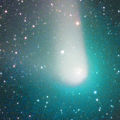
|
It brightened up to 8 mag from 2022 summer to 2023 spring. Now it is 15.6 mag (Nov. 11, ATLAS-HKO, Haleakala). It stays 16 mag for a while. It stays observable in good condition.
Date(TT) R.A. (2000) Decl. Delta r Elong. m1 Best Time(A, h)
Nov. 23 6 8.95 19 49.9 6.473 7.333 148 15.5 2:01 ( 0, 75)
Nov. 30 6 4.78 20 5.6 6.472 7.388 156 15.6 1:30 ( 0, 75)
|

|
Now it is 15.7 mag (Nov. 13, ATLAS Chile). Fading slowly. It stays observable in good condition.
Date(TT) R.A. (2000) Decl. Delta r Elong. m1 Best Time(A, h)
Nov. 23 6 40.22 10 24.5 2.705 3.511 139 15.6 2:32 ( 0, 65)
Nov. 30 6 38.00 10 3.1 2.663 3.524 145 15.6 2:03 ( 0, 65)
|
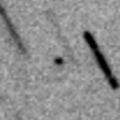
|
Fading gradually. It will be fainter than 18 mag in February. In the Northern Hemisphere, it will be unobservable in December. But it will be observable again in January. In the Southern Hemisphere, it will never be observable after this.
Date(TT) R.A. (2000) Decl. Delta r Elong. m1 Best Time(A, h)
Nov. 23 16 47.35 -3 0.0 2.802 1.918 21 15.6 18:19 ( 85, 2)
Nov. 30 17 4.21 -2 57.7 2.897 2.008 20 15.8 18:18 ( 86, 0)
|

|
Now it is 16.4 mag (Nov. 11, Ken-ichi Kadota). It stays 15 mag for a while. In the Southern Hemisphere, it stays observable in good condition.
Date(TT) R.A. (2000) Decl. Delta r Elong. m1 Best Time(A, h)
Nov. 23 8 9.95 -26 52.0 3.935 4.256 102 15.8 4:02 ( 0, 28)
Nov. 30 8 5.79 -26 40.8 3.823 4.231 107 15.7 3:30 ( 0, 28)
|

|
Now it is 16.0 mag (Nov. 20, Katsumi Yoshimoto). It stays 16 mag for a while. In the Northern Hemisphere, it stays observable in good condition.
Date(TT) R.A. (2000) Decl. Delta r Elong. m1 Best Time(A, h)
Nov. 23 1 46.47 16 45.9 2.121 3.014 149 15.8 21:35 ( 0, 72)
Nov. 30 1 43.77 16 4.1 2.151 2.988 141 15.7 21:05 ( 0, 71)
|
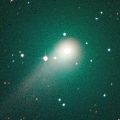
|
It was observed at 9-10 mag for a long time in 2023. Now it is 15.8 mag (Nov. 14, ATLAS Chile). It stays 16 mag for a while. In the Northern Hemisphere, it will never be observable after this. In the Southern Hemisphere, it will be getting lower gradually. But it will be getting higher again after February.
Date(TT) R.A. (2000) Decl. Delta r Elong. m1 Best Time(A, h)
Nov. 23 20 53.06 -64 46.0 6.414 6.065 65 15.9 18:19 ( 10,-11)
Nov. 30 20 54.38 -64 5.0 6.540 6.120 60 15.9 18:18 ( 13,-12)
|
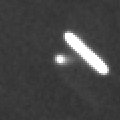
|
It will be observable at 15 mag for a long time in 2025 in the Northern Hemisphere. Now it is 16.5 mag (Nov. 12, ATLAS-HKO, Haleakala). It stays 16 mag for a while. In the Northern Hemisphere, it stays observable in good condition. In the Southern Hemisphere, it is not observable now, but it will appear in December.
Date(TT) R.A. (2000) Decl. Delta r Elong. m1 Best Time(A, h)
Nov. 23 12 3.42 28 40.6 4.845 4.675 74 16.0 5:13 (269, 55)
Nov. 30 12 8.08 29 54.2 4.716 4.653 80 15.9 5:19 (271, 62)
|

|
It will brighten rapidly after this. In the Northern Hemisphere, it will be unobservable in December. In the Southern Hemisphere, it is not observable now. It will brighten up to 10 mag in 2025 spring. But the condition of this apparition is bad. It is not observable when the comet is bright.
Date(TT) R.A. (2000) Decl. Delta r Elong. m1 Best Time(A, h)
Nov. 23 17 17.60 -1 59.8 2.699 1.877 27 16.3 18:19 ( 81, 9)
Nov. 30 17 33.84 -2 24.8 2.651 1.812 25 15.9 18:18 ( 82, 7)
|
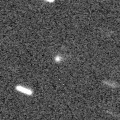
|
Now it is 16.5 mag (Nov. 2, Martin Masek). It stays 16 mag for a while. In the Northern Hemisphere, it stays observable in good condition. In the Southern Hemisphere, it will be getting higher gradually.
Date(TT) R.A. (2000) Decl. Delta r Elong. m1 Best Time(A, h)
Nov. 23 12 56.51 -0 23.8 2.539 2.015 47 16.0 5:13 (293, 29)
Nov. 30 13 10.39 -1 30.0 2.508 2.042 51 16.0 5:19 (298, 32)
|
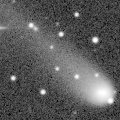
|
Now it is 15.8 mag (Nov. 6, ATLAS Chile). It stays 16 mag for a while. It stays extremely low in the Northern Hemisphere. In the Southern Hemisphere, it stays observable in good condition.
Date(TT) R.A. (2000) Decl. Delta r Elong. m1 Best Time(A, h)
Nov. 23 7 22.51 -49 11.9 6.092 6.283 96 16.0 3:14 ( 0, 6)
Nov. 30 7 14.21 -49 57.5 6.094 6.327 99 16.0 2:38 ( 0, 5)
|
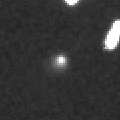
|
Now it is 16.4 mag (Nov. 12, ATLAS Chile). It stays 16 mag for a while. It locates somewhat low in the Northern Hemisphere. But it will become high in autumn. In the Southern Hemisphere, it stays observable in good condition.
Date(TT) R.A. (2000) Decl. Delta r Elong. m1 Best Time(A, h)
Nov. 23 7 8.72 -30 24.1 6.404 6.822 111 16.0 3:00 ( 0, 25)
Nov. 30 7 7.20 -30 37.1 6.337 6.810 114 16.0 2:31 ( 0, 24)
|

|
Now it is 16.8 mag (Oct. 31, Thomas Lehmann). Fading gradually. It will be fainter than 18 mag in March. It stays observable in good condition.
Date(TT) R.A. (2000) Decl. Delta r Elong. m1 Best Time(A, h)
Nov. 23 23 12.70 6 31.4 0.732 1.420 110 16.2 19:03 ( 0, 62)
Nov. 30 23 34.11 6 23.5 0.765 1.427 108 16.1 18:57 ( 0, 62)
|

|
Parent asteroid of Geminids meteor shower. Now it is 16.3 mag (Nov. 21, Katsumi Yoshimoto). It stays 16 mag for a while. In the Northern Hemisphere, it stays observable in good condition. In the Southern Hemisphere, it will be unobservable in March.
Date(TT) R.A. (2000) Decl. Delta r Elong. m1 Best Time(A, h)
Nov. 23 3 56.23 38 28.6 0.982 1.945 161 16.3 23:43 (180, 87)
Nov. 30 3 29.35 36 53.4 0.935 1.894 160 16.2 22:49 (180, 88)
|

|
Now it is 16.8 mag (May 18, ATLAS South Africa). It stays 16 mag for a while. It locates somewhat low in the Northern Hemisphere. In the Southern Hemisphere, it will be getting higher gradually.
Date(TT) R.A. (2000) Decl. Delta r Elong. m1 Best Time(A, h)
Nov. 23 12 4.40 -24 45.6 4.102 3.595 53 16.3 5:13 (321, 19)
Nov. 30 12 13.10 -25 53.2 4.023 3.585 57 16.3 5:19 (327, 21)
|

|
First return of a new periodic comet which brightened up to 15 mag in 2010. It is expected to brighten up to 15 mag from winter to spring, and it will be observable in excellent condition in the Northern Hemisphere. Now it is 17.4 mag (Nov. 6, Ken-ichi Kadota). Brightening slowly. In the Northern Hemisphere, it stays observable in good condition. In the Southern Hemisphere, it will be getting lower gradually.
Date(TT) R.A. (2000) Decl. Delta r Elong. m1 Best Time(A, h)
Nov. 23 2 28.98 6 56.2 1.081 2.021 155 16.6 22:17 ( 0, 62)
Nov. 30 2 22.68 7 55.1 1.072 1.977 147 16.4 21:44 ( 0, 63)
|
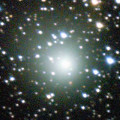
|
It brightened up to 8.3 mag in 2021-2022 winter (Jan. 6, 2022, Toshiyuki Takahashi). Now it is 15.1 mag (Aug. 2, Thomas Lehmann). It stays 17 mag for a while. In the Northern Hemisphere, it will never be observable after this. In the Southern Hemisphere, it stays observable in good condition.
Date(TT) R.A. (2000) Decl. Delta r Elong. m1 Best Time(A, h)
Nov. 23 12 24.91 -52 22.1 9.708 9.124 51 16.5 5:13 (334, -6)
Nov. 30 12 28.33 -53 1.5 9.707 9.168 54 16.5 5:19 (338, -4)
|

|
Now it is 16.5 mag (June 6, Giuseppe Pappa). It stays 16 mag for a while. In the Northern Hemisphere, it is not observable now, but it will appear in December. In the Southern Hemisphere, it will be getting higher gradually.
Date(TT) R.A. (2000) Decl. Delta r Elong. m1 Best Time(A, h)
Nov. 23 13 42.66 -41 12.0 5.998 5.219 34 16.6 5:13 (317, -7)
Nov. 30 13 43.64 -41 41.1 5.941 5.214 39 16.5 5:19 (321, -3)
|

|
Now it is 16.1 mag (Nov. 1, Thomas Lehmann). Fading slowly. It stays extremely low in the Northern Hemisphere. In the Southern Hemisphere, it stays observable in good condition.
Date(TT) R.A. (2000) Decl. Delta r Elong. m1 Best Time(A, h)
Nov. 23 9 27.55 -39 5.0 3.740 3.740 82 16.6 5:13 (359, 16)
Nov. 30 9 18.22 -40 19.6 3.692 3.787 87 16.6 4:42 ( 0, 15)
|

|
Now it is 16.6 mag (Nov. 8, Ken-ichi Kadota). It stays 17 mag for a while. It stays observable in good condition.
Date(TT) R.A. (2000) Decl. Delta r Elong. m1 Best Time(A, h)
Nov. 23 2 49.27 10 26.9 2.951 3.900 161 16.6 22:38 ( 0, 66)
Nov. 30 2 46.08 9 56.6 2.991 3.899 153 16.7 22:07 ( 0, 65)
|

|
Now it is 16.6 mag (Nov. 14, ATLAS-MLO, Mauna Loa). It stays 17 mag for a while. It will be unobservable in February in the Northern Hemisphere, or in December in the Southern Hemisphere. But it will be observable again in March in the Northern Hemisphere.
Date(TT) R.A. (2000) Decl. Delta r Elong. m1 Best Time(A, h)
Nov. 23 22 16.26 21 54.8 5.369 5.660 102 16.7 18:19 ( 13, 77)
Nov. 30 22 13.79 21 1.9 5.440 5.617 95 16.7 18:18 ( 36, 73)
|
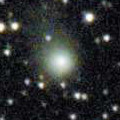
|
It brightened up to 12.1 mag in 2023 spring (May 20, 2023, Jose Guilherme de S. Aguiar). Now it is 16.7 mag (Nov. 12, ATLAS South Africa). It stays 17 mag for a while. It stays extremely low in the Northern Hemisphere. In the Southern Hemisphere, it stays observable in good condition.
Date(TT) R.A. (2000) Decl. Delta r Elong. m1 Best Time(A, h)
Nov. 23 6 38.18 -41 34.9 5.590 5.961 107 16.7 2:30 ( 0, 13)
Nov. 30 6 32.30 -41 36.1 5.598 6.010 110 16.8 1:57 ( 0, 13)
|
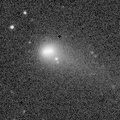
|
It brightened up to 13.5 mag in last winter (Dec. 5, 2023, Chris Wyatt). Now it is 16.6 mag (Nov. 10, J. Nicolas, F. Kugel). It stays 17 mag for a while. In the Northern Hemisphere, it will be getting higher gradually. In the Southern Hemisphere, it will be unobservable in December. But it will be observable again in December.
Date(TT) R.A. (2000) Decl. Delta r Elong. m1 Best Time(A, h)
Nov. 23 13 16.57 -1 21.3 3.375 2.737 43 16.8 5:13 (291, 24)
Nov. 30 13 26.09 -2 19.4 3.343 2.773 47 16.8 5:19 (296, 28)
|
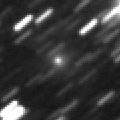
|
Very far object. Now it is 16.8 mag (Nov. 6, ATLAS Chile). It stays 17 mag for a while. In the Northern Hemisphere, it is not observable now. In the Southern Hemisphere, it stays observable in good condition.
Date(TT) R.A. (2000) Decl. Delta r Elong. m1 Best Time(A, h)
Nov. 23 1 7.21 -67 34.3 10.512 10.504 86 16.8 20:55 ( 0,-12)
Nov. 30 1 1.35 -66 54.6 10.573 10.512 83 16.8 20:22 ( 0,-12)
|

|
It brightened up to 12.0 mag in June (June 13, Ken-ichi Kadota). Now it is 17.3 mag (Oct. 31, Hirohisa Sato). Fading slowly. It will be fainter than 18 mag in February. In the Northern Hemisphere, it stays observable in good condition. It locates somewhat low in the Southern Hemisphere.
Date(TT) R.A. (2000) Decl. Delta r Elong. m1 Best Time(A, h)
Nov. 23 9 43.05 31 50.3 1.895 2.325 102 16.9 5:13 (305, 84)
Nov. 30 9 45.51 31 51.8 1.860 2.375 109 17.0 5:10 ( 0, 87)
|

|
Now it is 17.3 mag (Nov. 12, ATLAS Chile). It stays 17 mag for a while. It stays observable in good condition.
Date(TT) R.A. (2000) Decl. Delta r Elong. m1 Best Time(A, h)
Nov. 23 4 4.77 -16 17.4 3.138 3.974 143 17.1 23:53 ( 0, 39)
Nov. 30 4 0.87 -16 41.0 3.156 3.973 141 17.1 23:21 ( 0, 38)
|

|
Now it is 16.8 mag (Nov. 2, Toshihiko Ikemura, Hirohisa Sato). Fading gradually. It will be fainter than 18 mag in December. It stays observable in good condition.
Date(TT) R.A. (2000) Decl. Delta r Elong. m1 Best Time(A, h)
Nov. 23 0 41.63 -3 11.7 1.289 2.043 127 17.2 20:31 ( 0, 52)
Nov. 30 0 45.52 -2 35.0 1.357 2.050 121 17.3 20:07 ( 0, 53)
|

|
First return of a new periodic comet which brightened up to 15 mag in 2010. Now it is 18.7 mag (Nov. 4, Toshihiko Ikemura, Hirohisa Sato). Fading slowly. It will be fainter than 18 mag in February. In the Northern Hemisphere, it stays observable in good condition. It locates somewhat low in the Southern Hemisphere.
Date(TT) R.A. (2000) Decl. Delta r Elong. m1 Best Time(A, h)
Nov. 23 9 36.93 29 13.7 1.758 2.209 103 17.3 5:13 (330, 83)
Nov. 30 9 41.93 29 20.2 1.722 2.250 109 17.3 5:06 ( 0, 84)
|

|
It will brighten up to 14 mag in 2025 spring. Now it is 16.7 mag (Nov. 12, ATLAS Chile). Brightening gradually. In the Southern Hemisphere, it stays observable in good condition.
Date(TT) R.A. (2000) Decl. Delta r Elong. m1 Best Time(A, h)
Nov. 23 23 36.95 -28 21.2 1.602 2.036 101 17.3 19:26 ( 0, 27)
Nov. 30 23 40.69 -27 8.7 1.631 1.990 95 17.3 19:03 ( 0, 28)
|

|
Peculiar asteroid moving along a cometary orbit. It stays 17 mag for a while. It stays observable in good condition.
Date(TT) R.A. (2000) Decl. Delta r Elong. m1 Best Time(A, h)
Nov. 23 3 43.79 -13 11.8 1.916 2.793 146 17.3 23:32 ( 0, 42)
Nov. 30 3 38.40 -14 13.6 1.895 2.743 142 17.3 22:59 ( 0, 41)
|
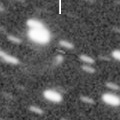
|
Now it is 17.4 mag (Nov. 7, ATLAS-HKO, Haleakala). It stays 18 mag for a while. In the Northern Hemisphere, it will be getting lower gradually. But it will be getting higher again after January. In the Southern Hemisphere, it is not observable now, but it will appear in February.
Date(TT) R.A. (2000) Decl. Delta r Elong. m1 Best Time(A, h)
Nov. 23 19 8.81 18 58.0 5.046 4.659 61 17.4 18:19 ( 84, 43)
Nov. 30 19 10.91 17 54.0 5.152 4.684 56 17.5 18:18 ( 86, 38)
|
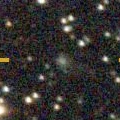
|
Now it is 17.8 mag (Nov. 6, Toshihiko Ikemura, Hirohisa Sato). It stays 18 mag for a while. In the Northern Hemisphere, it stays observable in good condition. It stays extremely low in the Southern Hemisphere.
Date(TT) R.A. (2000) Decl. Delta r Elong. m1 Best Time(A, h)
Nov. 23 7 42.75 40 46.6 6.364 7.014 127 17.4 3:35 (180, 84)
Nov. 30 7 41.74 41 1.5 6.302 7.027 134 17.4 3:07 (180, 84)
|

|
It brightened up to 14.4 mag in summer (Aug. 17, Hiroshi Abe). Now it is 17.3 mag (Nov. 11, ATLAS-HKO, Haleakala). It will fade out rapidly after this. It will be fainter than 18 mag in December. In the Northern Hemisphere, it stays observable in good condition. It stays extremely low in the Southern Hemisphere.
Date(TT) R.A. (2000) Decl. Delta r Elong. m1 Best Time(A, h)
Nov. 23 6 10.74 41 29.2 0.978 1.871 144 17.5 2:04 (180, 84)
Nov. 30 6 1.09 43 41.5 0.999 1.919 150 17.7 1:27 (180, 81)
|

|
Now it is 17.8 mag (Oct. 20, Ken-ichi Kadota). Fading slowly. It will be fainter than 18 mag in January. In the Northern Hemisphere, it stays observable in good condition. It locates somewhat low in the Southern Hemisphere.
Date(TT) R.A. (2000) Decl. Delta r Elong. m1 Best Time(A, h)
Nov. 23 10 6.44 31 35.2 2.206 2.541 98 17.8 5:13 (288, 80)
Nov. 30 10 10.69 31 35.0 2.154 2.577 103 17.8 5:19 (316, 85)
|
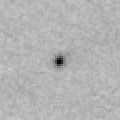
|
Now it is 17.4 mag (Nov. 4, ATLAS-MLO, Mauna Loa). It stays 18 mag for a while. It stays observable in good condition.
Date(TT) R.A. (2000) Decl. Delta r Elong. m1 Best Time(A, h)
Nov. 23 7 1.64 -4 18.8 3.914 4.588 127 17.8 2:54 ( 0, 51)
Nov. 30 6 59.25 -5 12.4 3.844 4.580 133 17.8 2:24 ( 0, 50)
|
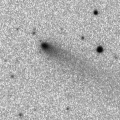
|
Now it is 17.8 mag (Nov. 1, Purple Mountain Observatory, XuYi Station). Fading slowly. It will be fainter than 18 mag in December. It stays observable in good condition.
Date(TT) R.A. (2000) Decl. Delta r Elong. m1 Best Time(A, h)
Nov. 23 3 6.38 15 57.4 3.585 4.555 167 17.8 22:55 ( 0, 71)
Nov. 30 3 2.10 15 48.2 3.629 4.567 159 17.8 22:23 ( 0, 71)
|

|
Now it is 17.9 mag (May 17, J. L. Virlichie, P. Traverse, H. Roy). It stays 18 mag for a while. In the Northern Hemisphere, it is not observable now, but it will appear in December. In the Southern Hemisphere, it will be getting higher gradually.
Date(TT) R.A. (2000) Decl. Delta r Elong. m1 Best Time(A, h)
Nov. 23 12 54.10 -47 8.0 6.205 5.554 45 17.9 5:13 (327, -5)
Nov. 30 12 56.72 -47 18.0 6.140 5.540 48 17.9 5:19 (331, -2)
|

|
Now it is 17.4 mag (Oct. 1, Martin Masek). Fading slowly. It will be fainter than 18 mag in December. In the Northern Hemisphere, it stays observable in good condition. It locates somewhat low in the Southern Hemisphere.
Date(TT) R.A. (2000) Decl. Delta r Elong. m1 Best Time(A, h)
Nov. 23 7 5.67 34 36.4 1.325 2.146 135 17.9 2:58 ( 0, 90)
Nov. 30 7 5.12 35 6.4 1.298 2.166 142 17.9 2:30 (180, 90)
|
|
![]()
 30P/Reinmuth 1
30P/Reinmuth 1 C/2019 U5 ( PanSTARRS )
C/2019 U5 ( PanSTARRS ) C/2022 R6 ( PanSTARRS )
C/2022 R6 ( PanSTARRS ) 305P/Skiff
305P/Skiff (3200) Phaethon
(3200) Phaethon C/2023 T3 ( Fuls )
C/2023 T3 ( Fuls ) P/2024 S3 ( Hill )
P/2024 S3 ( Hill ) C/2019 L3 ( ATLAS )
C/2019 L3 ( ATLAS ) C/2023 F3 ( ATLAS )
C/2023 F3 ( ATLAS ) C/2022 L2 ( ATLAS )
C/2022 L2 ( ATLAS ) 276P/Vorobjov
276P/Vorobjov C/2023 R1 ( PanSTARRS )
C/2023 R1 ( PanSTARRS ) C/2020 K1 ( PanSTARRS )
C/2020 K1 ( PanSTARRS ) 32P/Comas Sola
32P/Comas Sola C/2019 E3 ( ATLAS )
C/2019 E3 ( ATLAS ) 154P/Brewington
154P/Brewington 242P/Spahr
242P/Spahr 253P/PanSTARRS
253P/PanSTARRS 492P/2024 O3 ( LINEAR )
492P/2024 O3 ( LINEAR ) 49P/Arend-Rigaux
49P/Arend-Rigaux (308607) 2005 WY3
(308607) 2005 WY3 C/2022 U1 ( Leonard )
C/2022 U1 ( Leonard ) C/2021 S4 ( Tsuchinshan )
C/2021 S4 ( Tsuchinshan ) 146P/Shoemaker-LINEAR
146P/Shoemaker-LINEAR 50P/Arend
50P/Arend 195P/Hill
195P/Hill 117P/Helin-Roman-Alu 1
117P/Helin-Roman-Alu 1 C/2024 G2 ( ATLAS )
C/2024 G2 ( ATLAS ) P/2024 S2 ( Rankin )
P/2024 S2 ( Rankin )![]()























































